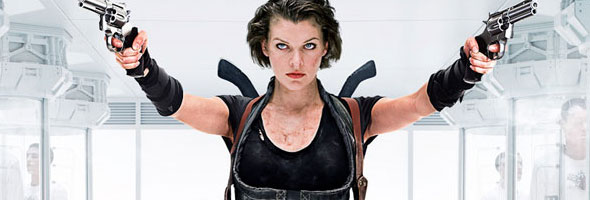Twenty years ago, the story arc of a video game existed almost entirely as a way to structure the action. The medium itself was such a novelty back then, at least as a home entertainment console, that people were looking for the most simplistic outline possible. It was harder to multi-task back when bands like Quiet Riot existed. Plus, there were four buttons to deal with, not counting the up, down, left and right arrows. Remembering details of why Bowser kidnapped the princess and how he recruited an army of oddly-shaped henchmen and cloud villains just didn’t seem relevant. You were good, they were evil, and as long as you could get a running start and grab the flag, it was all going to work out in the end. But then a funny thing happened on the way to Funcoland, the novelty wore off, and video game story arcs could no longer exist merely to structure the action.
Which brings us to Resident Evil: Afterlife, the first video game adaptation filmed with the 3D technology used in James Cameron’s Avatar. In many ways, it’s strikingly modern. Falling three dimensional droplets of water perfectly bookend a few fight scenes, 300-like slow motion nicely stutters breakneck action sequences allowing the viewer full appreciation of Alice’s samurai quickness, and hideous, CGI-ed beasts accentuate the fantastical, undead video game elements so many players fell in love with. But for all its twenty-first century camera tricks and eye-popping visual aids, Resident Evil: Afterlife doesn’t seem to comprehend that it’s not 1985. Story arcs can no longer exist merely to structure the action. We need real characters, we need real motivations and for God’s sake, we need a reason to give a shit.
Alice (Milla Jovovich) is a genetic anomaly, living in a wasteland populated almost entirely by zombies. The nefarious Umbrella Corporation, led by Albert Wesker (Shawn Roberts), has been hunting her for years in an effort to harness her DNA, but all their vile aims, thus far, have failed abysmally. In return, Alice has devoted her life to finding other survivors and when the fancy strikes her, turning the umbrella inside out. Periodically, she’s joined on her quest by fellow human Claire Redfield (Ali Larter), but tragically, since we saw her last, she’s developed amnesia. This slight mental disability, thankfully, only proves a minor hiccup, and soon the pair commandeers a plane and hits up an old prison in an attempt to save a few fellow lost souls.
In a wild stroke of luck, one of those fellow lost souls turns out to be an ass-kicking machine named Chris Redfield (Wentworth Miller), who, wait for it, happens to be Claire’s long-lost brother. Along with the other survivors, Alice and company hatch a plan to escape and find Arcadia, a supposedly bristling utopia where disease-free people carouse. The plane initially seems like the right way to escape, but as it won’t hold everyone, the gang must forage through the sewer system to find a boat. We all know good things never happen in the sewer.
The problem with Resident Evil: Afterlife is not the story arc, it’s how that arc is compromised again and again in ways eerily-reminiscent of old, hollow video games. Take one of the side characters, a perky girl who may as well not have a name. The only real fact we learn about her is that she was a champion swimmer. How bizarrely handy when they need someone to dive into the water. Don’t worry about her though. She won’t be around after her skill is no longer needed. Take Claire’s amnesia. Why does she have amnesia? Because she can’t just start out cooperating with her brother. Then who would be left to triumphantly join forces? Take the hooded-goliath like creature who shows up to knock the prison walls down. Why, unlike the other zombies, is he able to use weapons and conceivably, powers of reason? Does he work for the Umbrella Corporation? Is he acting on his own agency? That’s right, he must be a boss, which means we must be at the end of a level.
In a lot of ways, Resident Evil: Afterlife is a product of this exact moment. It’s excited about its graphics, hung up on the new 3D technology at its finger tips, but in even more ways, in all of the important ways, it’s an adaptation which will soon feel decades behind its time. Just as the Spider-Man trilogy seemed trivial and surface-level after The Dark Knight, Resident Evil: Afterlife will lose all value when the luster of its new, cutting-edge graphics fades. Every day, new games like God Of War and Uncharted are being released that use violence to further the story arc. The novelty of cartoonish killing without well-developed backstory is over, soon the third dimension for third dimension’s sake will seem idiotic and outdated. What will that leave Resident Evil with? A few zombie fights in a sewer. We all know good things never happen in the sewer. Unless, of course, they involve Ninja Turtles or Andy Dufresne.
You've read the review, now for an in-depth analysis of Resident Evil: Afterlife's 3D go here.
Mack Rawden is the Editor-In-Chief of CinemaBlend. He first started working at the publication as a writer back in 2007 and has held various jobs at the site in the time since including Managing Editor, Pop Culture Editor and Staff Writer. He now splits his time between working on CinemaBlend’s user experience, helping to plan the site’s editorial direction and writing passionate articles about niche entertainment topics he’s into. He graduated from Indiana University with a degree in English (go Hoosiers!) and has been interviewed and quoted in a variety of publications including Digiday. Enthusiastic about Clue, case-of-the-week mysteries, a great wrestling promo and cookies at Disney World. Less enthusiastic about the pricing structure of cable, loud noises and Tuesdays.











